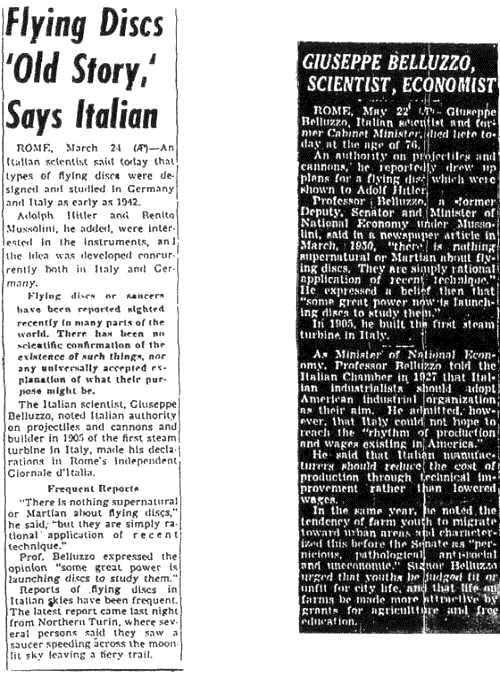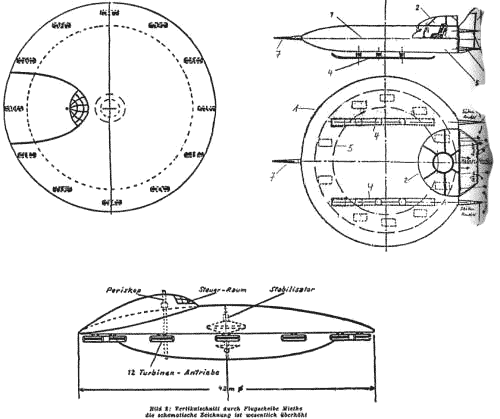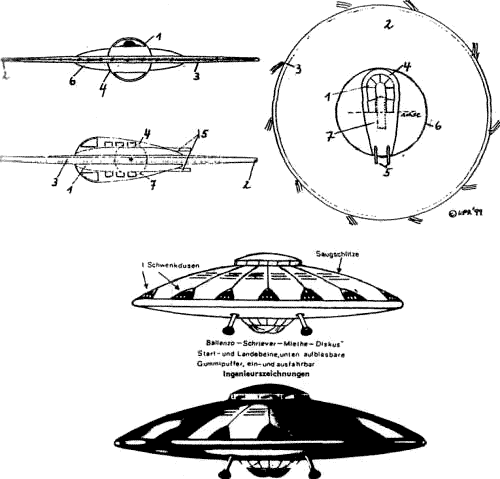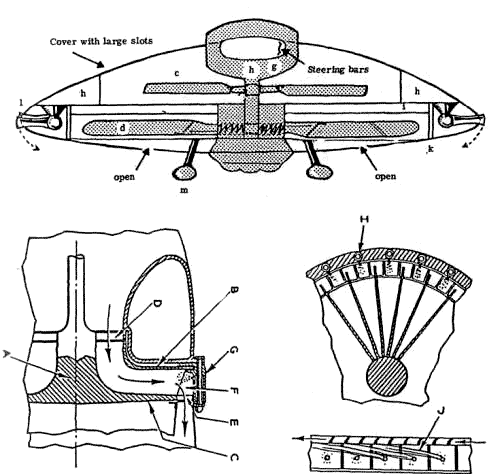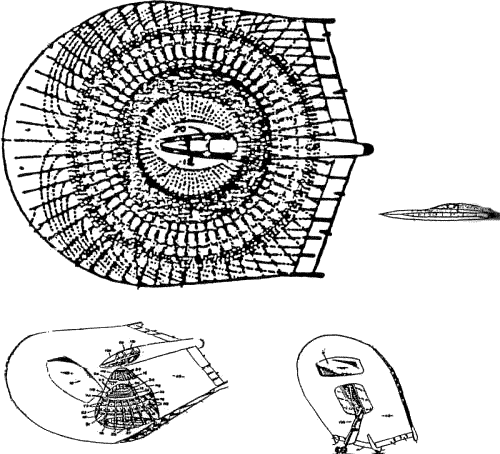|
The Miethe-Belluzzo ProjectThis saucer project may have been an outgrowth of flying wing research. It was begun in 1942, and was under the on-site authority of Dr. Richard Miethe, sometimes called Dr. Heinrich Richard Miethe. Not much is known about Dr. Miethe before the war. After the war Dr. Miethe is rumored to have worked on the Anglo-American saucer project at the firm of Avro Aircraft Limited of Canada. Such is stated Klein (1)/ Epp (2), Barton (3), Lusar (4), as well as a myriad of other sources. We will return to the Avro projects later. Working with Dr. Miethe was an Italian engineer, Professor Guiseppe Belluzzo. Belluzzo was the Deputy, Senator and Minister of National Economy under Mussolini. He had written several books on technical matters including Steam Turbines in 1926 and calculations and Installations of Modern Turbine Hydrolics in 1922 (names are English translations of Italian titles).Belluzzo was considered to be an expert in steam turbines. Dr.Belluzzo was not a junior scientist and he was not Dr. Miethe's assistant. He was a senior scientist whose expertise was somehow invaluable on the saucer devices or planned further developments of them. After the war Belluzzo seems to have led a quiet life in Italy until his death on 5/22/52. Unlike Miethe, however, Belluzzo went on record about German flying discs after the war. He is quoted on the subject in The Mirror, a major Los Angeles newspaper in 1950. This may be the first mention of the subject in the American press. In his obituary in the New York Times his work on the German saucer program is mentioned. (Please refer to copies of these articles). This team worked in facilities in, Dresden, Breslau and Letow/Prag according to Epp (5). Both this project and the Schriever and Habermohl projects were directed by the same experts and advisors (6). From Epp's discussion, it is clear that Dr. Walter Dornberger first evaluated and recommended his saucer model for further development (7). Miethe is described by Epp in translation as a "known V-weapons designer"(8). The association of both projects to Peenemuende is clear. Both were sanctioned and set up by officials there, probably by Dr. Walter Dornberger himself. Miethe and Belluzzo worked primarily in Dresden and Breslau but for a brief time they may have actually joined forces with Schriever and Habermohl in Prag, as evidenced by Klein's statement that three saucer models were destroyed on the Prag tarmac (9). One saucer, which Klein he describes as Miethe's was among these. Klein acknowledges that Peenemuende,and its nearby test facility at Stettin, retained and developed the Miethe design as an unmanned vehicle (10)(11). Epp tells us that the Miethe-Belluzzo project was organized under exactly the same authority as the Schriever-Habermohl project and he further identifies the very same industrial firms which supported Schriever-Habermohl as supporting this project (12).In reality, both should be viewed as one project with different aspects.
Giuseppe Belluzzo On the left, a column from The Mirror, dated March 24, 1950. This is one of the earliest English references toGerman flying discs. On the right is Dr. Belluzzo's obituary, dated May 22, 1952 from the New York Times whichagain mentions German flying discs. The designs envisioned by Dr. Miethe and Professor Belluzzo were quite different from those of Schriever and Habermohl. Designs of this project consisted of a discus-shaped craft whose outer periphery did not rotate. Two designs have positively been attributed to Miethe and Belluzzo although three designs exist as part of their legacy. The first design is made known to us from Georg Klein's article in the October 16, 1954 edition of the Swiss newspaper, Tages-Anzeiger fuer Stadt und Kanton Zuerich, mentioned above. The same design is reproduced in the book by J. Andreas Epp. This saucer was not intended to take-off vertically but at an angle as does a conventional airplane. In this design twelve jet engines are shown to be mounted "outboard" to power the craft. The cockpit was mounted at the rear of the vehicle and a periscope used to monitor directions visually impaired. Notably, a large gyroscope mounted internally at the center of the craft provided stability. This and other Miethe-Belluzzo designs were said to be 42 meters or 138 feet in diameter. Aeronautical writer Hans Justus Meier has challenged this design on a number of grounds (13). It is certainly possible, if not probable, that the outboard jet-turbine arrangement is incorrect,one might ask, if this was an outboard jet-turbine design, then what purpose did the bloated central body serve? In reality the twelve jets may simply have been jet nozzles of one engine. Certainly the large central body had a function, it must have housed the engine. But how could the authenticity of this design come under question when Georg Klein is vouching for it in his article? The answer may be that Klein never saw this design himself and he simply is relying on the descriptions of those that did. If one reads the works of Klein carefully, he never claims to have seen this model in flight. As a matter of fact, he never claims to have actually seen this design at all. We will return to the flaws with Klein's description momentarily. The second Miethe design seems to have originated with a 1975German magazine article (14). This version shows a cockpit above and below the center of the craft. Four jet engines lying behind the cockpits are shown as the power plants. No real detail is supplied in this article. This design is not ever discussed in the text which deals primarily with the Schriever-Habermohl Project. Some writers have speculated on this particular design, supplying detail (15). For now, however, no named source seems to be able to link this design with the Miethe-Belluzzo Project. Therefore, at least for the time being, we must put this design in suspense and focus on the first and next design in discussing the aforementioned saucer project. The Miethe-Belluzzo Disc--Design One On the left is a reconstruction by Georg Klein, 10/16/54, from the Swiss newspaper Tages-Anzeiger. Note the small "Stabisator" and the outboard jet engines. On the right is Klaus-Peter Rothkugel's more probable reconstruction incorporating fins, skids, and the inner-lying Rene Leduc engine. The Miethe-Belluzzo Disc Designs Two And Three On the top is Miethe-Belluzzo design two. Note rotating disc (2) and stabilizing wheel (7) acting as a gyroscope.(Courtesy of Klaus-Peter Rothkugel) It is the author's opinion that this design was never built. On the bottom is Miethe-Belluzzo design three, capable of vertical take-off. The third design attributed to the Miethe-Belluzzo Project comes to us from and article by Jan Holberg in an August 20, 1966 article in Das Neue Zeitalter and also from Michael X. Barton-Carl F. Mayer-Hermann Klaas connection (16) (17). This design was capable of vertical take-off. Klaas provides internal detail which has been reproduced here. At first, this appears to be a push-pull propeller system driven by a single engine. It is not. Neither are the twelve jet nozzles unsupported in any way as depicted. The real answer to this mystery is that this drawing is incomplete. With the completed parts depicted, a radial turbojet engine of special type would appear. Design one differs from design three in that the latter, with its centrally located cabin and symmetrical arrangement of twelve adjustable jet nozzles, is controlled by selectively shutting off various jets through the use of surrounding ring. This allows the saucer to make turns and to take off vertically. Recently, a German researcher, Klaus-Peter Kothkugel using Vesco as his source (18), has proposed an engine which links the designs one and three, and possibly even design two, while supplying the missing pieces needed to make the engine depicted air-worthy and resolves other problems. This engine was invented by a French engineer, Rene Leduc and probably acquired by the Germans during their occupation of France. If a flying saucer equipped with this engine were viewed from the outside, no rotating parts would be visible. This is because the engine was totally contained within the metal skin of the saucer.It did rotate but this rotation was within the saucer itself and not viable from the outside. An air space existed all around the spinning engine, between it and the non-rotating outer skin.This engine was a type of radial-flow jet engine. It was this type of engine which probably powered all of Dr. Miethe's saucer designs. It is also the prime candidate for the post-war design of John Frost, the "Flying Manta." The Flying Manta actually did fly. Pictures of it during a test flight are unmistakable. They were taken on July 7, 1947 by William A. Rhodes over Phoenix, Arizona. It almost goes without saying that the time frame, July of 1947, as well as the geographical location, the American Southwest, as well as the description of the flying object itself, beg comparisons to the saucer which crashed at Roswell, New Mexico, earlier that same month. If one looks at what is known of Dr. Miethe's saucer design, the Leduc engine, and the Frost Manta, it must be acknowledged that a connection between these three not only explains apparent inconsistencies in the existing Miethe designs but also links them to the post-war American Southwest, the precise spot where captured German World War Two technology was being tested and evaluated. The Rene Leduc Engine Top: Hermann Klaas' diagram of the workings of the Miethe-Belluzzo Disc. Note: intake screw (c) Carrying wing blade(d)affixed to a piston engine, jets nozzles (e) with no apparent engines. Close but not exactly right. Bottom: Leduc design. A-Rotor B-Front Bulk-head C-Rear Bulk-head D- Intake Vane E-Compressor Vane F-Combustion Chamber G-Bulk- head H-Fuel Injection Jets J-Fixed Flame Ring From IVelivoli Del Mistero I seareti technici dei dischi volanti by Renato Vesco The Rene Leduc Engine Part Two This is the mounting of the Leduc engine as illustrated by the later Avro diagram (Canada-USA). The outer hull is fixed. The inner rotating engine draws in the air from between it and the hull and exhausts through rear or sides as needed for steering. Compare this design to Miethe- Belluzzo designs, especially to the first design. There is considerable confusion as to where the first test flight of the Miethe-Belluzzo saucer occurred. Epp tells us that models made by this team were flight tested since 1943. Georg Klein, as well as Andreas Epp, state that a test model of this craft took off from Stettin, in northern Germany, near Peenemuende, roughly where the Oder River meets the Baltic, and crashed in Spitsbergen which are the islands to the north of Norway. A manned test flight in December, 1944 has been mentioned by Norbert Juergen-Ratthofer and Ralf Ettl in one of the films on which they worked. The pilot named was Joachim Roehlicke or perhaps Hans-Joachim Roehlicke (19). Klaus-Peter Rothkugel reports that Roehlicke was under the direction of none other than Dr. Hans Kammler himself and was stationed at the Gotha Wagonfabrik company (20). The Gotha Wagonfabrik company is Anthe Jonas Valley in Thuringia. This valley was packed full of high-tech underground facilities which included nuclear research. Roehlicke confided to his daughter after the war, according to Mr. Rothkugel, that he "had seen the earth from above" (21). Confusion over the test details of the Miethe-Belluzzo saucer start as early as the whole German flying disc controversy its elfin the 1950s. In the English translation of his book, titled Brighter than a Thousand Suns A Personal History Of The Atomic Scientists. a footnote appeared which deviated from the discussion of atomic weaponry. This 1958 description is one ofthe first in English and may illustrate some of the difficulties in sorting out this information: " *The only exception to the lack of interest shown by authority was constituted by the Air Ministry. The Air Force research workers were in a peculiar position. The produced interesting new types of aircraft such as the Delta (triangular)and "flying discs." The first of these "flying saucers," as they were later called -- circular in shape, with a diameter of some 45yards--were built by the specialists Schriever, Habermohl and Miethe. They were first airborne on February 14, 1945, over Prague and reached in three minutes a height of nearly eight miles. They had a flying speed of 1250 m.p.h. which was double din subsequent tests. It is believed that after the war Habermohl fell into the hands of the Russians. Miethe developed at a later date similar "flying saucers" at A. V. Roe and Company for the United States." (22). One big difference between the Miethe-Belluzzo design and the Schriever-Habermohl designs is that the former craft was alleged to have, or be designed to have, a longer flight range. This point is reinforced by the Spitz bergen flight mentioned above.Klein states that the Germans considered long range, remote controlled attack from Germany to New York using this craft. Miethe-Belluzzo Saucer In Flight 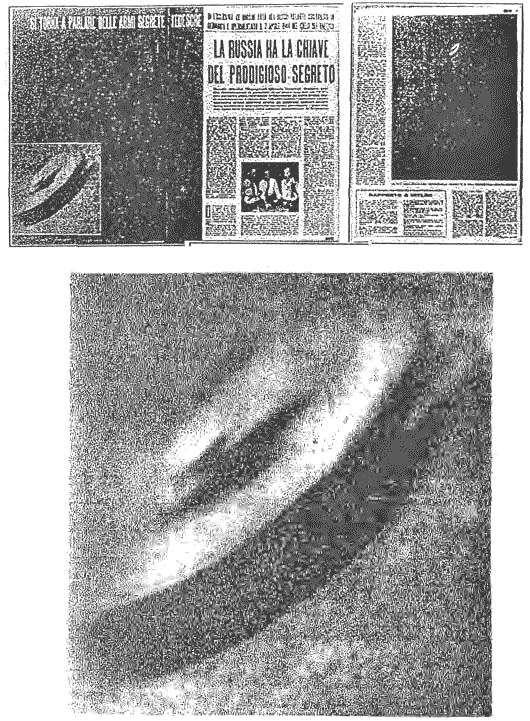
Top picture is of a September 6, 1952 article in the Italian newspaper "Tempo". This article deals with the work of Dr. Miethe and features a photograph of his saucerallegedly dated April 17, 1944, taken over the Baltic. Bottom is an enlargement of the photograph. It seems to be a Miethe-Belluzzo type 1 but could also be a type 3. Courtesy of Klaus-Peter Rothkugel. As stated earlier, both projects were under the same authority. Experts and advisors included, according to Epp, among others, head-designer Kalkert of the Gotha Waggonfabrik, head-designer Guenther of Heinkel, engineer Wulf of Arado, engineer Otto Lange of the RLM, and engineer Alexander Lippish of Messerschmitt. Pilots were Holm, Irmler, Kaiser and Lange. The test pilot was Rudolf Schriever. There does exist two alleged still pictures of the Miethe craft in flight. One is reproduced here. It may be the first design.A picture claiming to be of what is called here the third design can be found in W. Mattern's book, UFO's Unbekanntes Flugobiekt?Letzte Geheimwaffe Des Dritten Reiches? (23). Efforts have been made to acquire the picture for this book but the inquiry went unanswered by the book's publisher. Politically, in 1944, Heinrich Himmler, head of the SS, replaced Albert Speer's appointee, Georg Klein, with Dr. Hans Kammler as overseer of this combined saucer project (24). This is a little confusing, however, since Kammler retained Klein as his employee,Perhaps a more practical way to look at this is that Kammler, Himmler's employee, replaced Speer while Klein did what he always did. The result was that the SS took direct and absolute control over these projects from this point until the end of the war. Prior to this happening, news of these designs or application itself was made to the German Patent Office. All German wartime patents were carried off as booty by the Allies. This amounted to truckloads of information. Fortunately, Rudolf Lusar, an engineer who worked in the German Patent Office during this time period, wrote a book in the 1950s listing and describing some ofthe more interesting patents and processes based upon his memory of them (25). They are surprisingly detailed. Included is the Schriever saucer design with detail. Also discussed is the Miethe project. The significance of these two teams can not be minimized in the history of flying saucers or UFOs. Already in this brief discussion, the evidence, taken as a whole, is overwhelming.Please compare this to any and all extraterrestrial explanations of flying saucers. Here we have Germans who claim to have invented the idea of the flying saucer. We have Germans who claim to have designed flying saucers. We have Germans who claim to have built flying saucers. We have Germans who claim to have flown flying saucers. We have Germans who claim to be witnesses to flying saucers known beforehand to be of German construction. We have German construction details. And finally, we have a man who took pictures of a known German flying saucer in flight. The facts speak for themselves. During the Second World War the Germans built devices we would all call today "flying saucers". No other UFO explanation can even approach this in terms of level of proof. Miethe-Belluzzo Saucer In America? 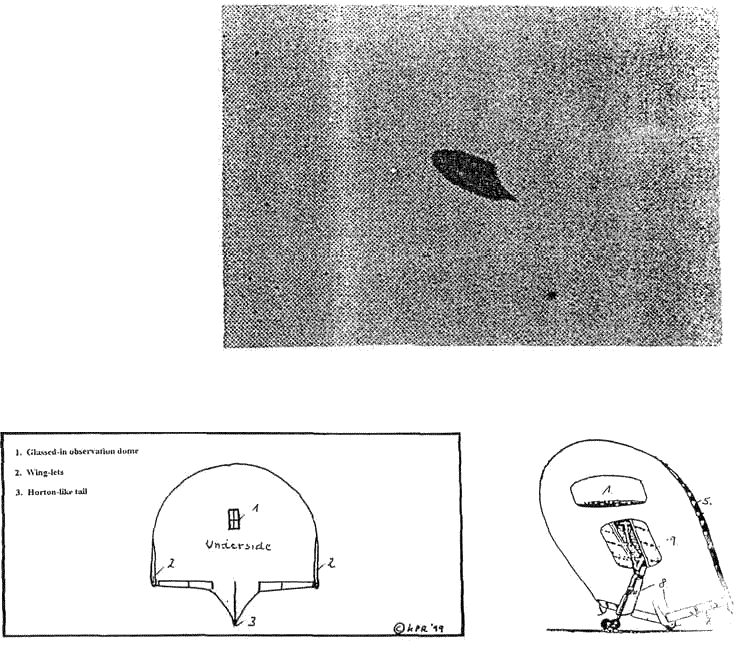
Top: a picture from the July 9, 1947 edition of theArizona Republic taken by William A. Rhodes as it flew over his home in Phoenix. Lower Left: a drawing of thecraft by Klaus-Peter Rothkugel. Lower Right: one view of the Avro Frost-Manta design, predating the Silver BugProject. Was this a captured Miethe-Belluzzo-Leduc saucer? Sources and References
Section IndexIndex |
